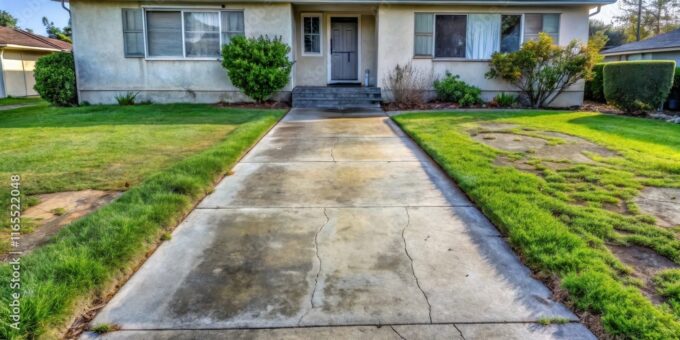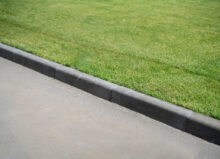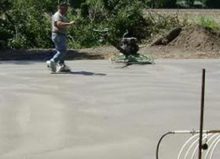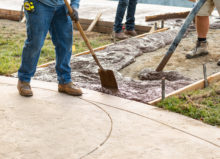Exploring Different Types of Concrete Walkways for Residential Properties

It’s difficult to know how certain hardscaping elements, like walkways, will look on your property until they’re installed. But, the challenge is that you need to be certain about how you want that element to be designed before it’s installed.
With walkways in particular, there are several design choices you can choose from, including pavers, classic poured concrete, and gravel. Each material type/design choice has distinct benefits and drawbacks that will not only impact the walkway’s aesthetic but also its durability, safety, and maintenance requirements.
Let’s explore more below.
Paver
Paver walkways are made from precast concrete (usually in a unique pattern, texture, or color) and individually installed. They’re the more high-end option compared to the other design choices we’ll cover.
Advantages
- Versatility: Since they’re made from precast concrete, they come in multiple colors, patterns, and textures. They can even mimic the appearance of natural brick or stone.
- Durable: They can handle heavy foot traffic and resist cracking better than large poured slabs.
- Easy to Repair: If a specific section of the walkway becomes stained or damaged, you can replace individual pavers without disturbing or repairing the entire walkway.
- Improved Traction: Because pavers can be textured, they provide better grip and reduce any risk of slipping, especially in icy or wet conditions.
Limitations
- Cost: The material and labor costs are higher compared to poured concrete, primarily because each paver has to be individually installed and aligned, and certain patterns or textures cost more.
- Maintenance: Weeds and moss can grow between the pavers/in joints, so occasional cleaning and sealing are required.
- Potential Shifting: If there isn’t secure edging, pavers may settle or shift over time (a significant safety hazard!)
Poured Concrete
As the name suggests, poured concrete walkways are made by pouring liquid concrete onto a base surface. While poured concrete isn’t as aesthetically pleasing as pavers, it can be stamped or stained.
Advantages
- Cost: Poured concrete is less expensive to install.
- Durability: Similar to pavers, poured concrete will last for a while in varying foot traffic and weather conditions as long as it’s maintained.
- Minimal Upkeep: Poured concrete is easier to maintain than pavers, but it does have similar requirements (cleaning and sealing), although these tasks don’t have to be performed as frequently.
- Versatility Is Still an Option: Poured concrete can be stamped, stained, or made with an exposed aggregate finish to slightly improve upon concrete’s natural neutral tones.
Limitations
- Prone to Cracking: Concrete expands and contracts with temperature changes, making it susceptible to cracks over time.
- Harder to Repair: If cracks and other flaws appear on the surface, they can be harder (and more expensive) to correct than with pavers.
- Limited Design: Although poured concrete can be stamped and stained, there still aren’t as many variations as with pavers.
- Increased Costs With Decorative Options: If you do want a decorative option, it will be more expensive than standard poured concrete due to higher labor costs. Decorative concrete also needs to be sealed more frequently to preserve its color.
Gravel
Gravels are a go-to for homeowners who don’t want to front the cost of a professional installation. These walkways are made from loose stones or crushed rock and can blend into garden landscapes and other spaces, if done correctly.
Advantages
- Excellent Drainage: Gravel naturally allows water to seep through.
- Affordable: Gravel is an affordable material, and minimal labor is required for installation.
- Easy to Modify: Gravel walkways don’t require extensive preparation and can be expanded or reshaped if needed.
Limitations
- Ongoing Maintenance: Loose gravel can shift or sink into the ground, so gravel walkways require regular raking to ensure they look uniform. You may find that you have to add more gravel to the walkway, too.
- Less Stability: This option isn’t particularly good in high-traffic areas or if people using strollers or wheelchairs (or individuals with general mobility issues) are going to be using the walkway.
- Lots of Potential for Weeds & Mud: It’s hard to keep a gravel walkway looking “neat.” Without proper edging or a weed barrier, grass and weeds will grow through it. And, if you live in an area prone to heavy rainfall (most areas in Michigan), you’ll often deal with a messy-looking walkway as the gravel will mix with mud.
Find Your Solution Today
Now is the perfect time to start planning a walkway. Ultimately, the design/material you choose will vary based on your environment, budget, and who will be using it. If you need help planning your project, turn to G&G Concrete & Construction. We have over two decades of experience helping homeowners throughout southeast Michigan install walkways, patios, driveways, and other concrete structures.
Visit our website to learn more about our capabilities, or contact us today to get started with a free project consultation and quote.







